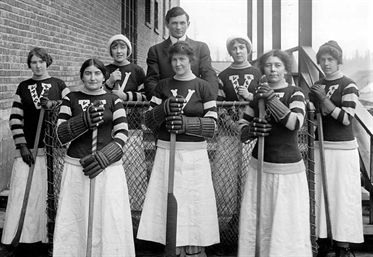Puck pioneers
Puck pioneers
Book explores early roots of women’s hockey

 Pictured outside the Denman Street Arena, the 1914 Vancouver Ladies' Hockey Team helped to pioneer the sport in Western Canada.
Pictured outside the Denman Street Arena, the 1914 Vancouver Ladies' Hockey Team helped to pioneer the sport in Western Canada.
Wayne Norton is a Victoria-based author and historian, and a former teacher at Kamloops Secondary School. We interviewed him about Women on Ice: The Early Years of Women’s Hockey in Western Canada (Ronsdale Press), which had an unusual genesis.
What inspired you to write Women on Ice, and how did you go about researching it?
About 20 years ago, I was putting together a book on the history of Fernie, a small city in southeastern British Columbia, when I came across a photograph of a women’s team called the Fernie Swastikas, dated 1923. It was a shock, not only because of the emblem on the team’s sweaters, but also because I had no idea women played hockey in the 1920’s. I decided to include an article about the Swastikas in the book, and began to learn about their opponents from Calgary and Vancouver and the importance of the annual women’s hockey tournament at Banff.
That in turn made me curious about the whole history of the women’s game in Western Canada. I felt I had to try to tell the larger story, but research was frustrating. The players were long gone and sources of information were few. I had to rely heavily on newspaper stories—a source that a historian of any topic has to treat with caution.
Clearly, the Swastikas had a name that would be totally inappropriate today. Can you put that name in context and describe their place in BC hockey history?
There were “Swastika” skating clubs in many Canadian communities in the early 20th century, and teams associated with the clubs took that name. There was one such club in Vancouver during the war years. I think the Fernie players (who were all teachers and office clerks) simply adopted the name without forming an official skating club. The emblem was just an ancient symbol of good fortune and had no political association until it was adopted and corrupted by the Nazis. As you said, no team today could consider calling themselves by that name.
The Fernie Swastikas were the second (and last) team from British Columbia to win the Alpine Cup at the annual Banff Winter Carnival. That cup deserves a mention. It was donated by the Alpine Club of Canada in 1920/21 with the express intention that it should be the female equivalent of the Stanley Cup. Its whereabouts today is not known.
Just how different was the women’s game in the early days from what we see today?
The game before 1914 was different in two significant ways. Beginners always begin with the skills levels of beginners. Women players were often gently ridiculed by newspaper reporters in the years before the First World War. As playing abilities improved dramatically, that seems to have largely disappeared by the end of the war. I am aware of no such ridicule in the reporting of women’s games today.
The other change is a visual one, but that too had changed dramatically by the 1920’s. Women players before the First World War were expected to dress “respectably.” That meant long, heavy skirts on and off the ice. That changed quickly. If you look at the photograph of the Fernie Swastikas in 1923, they are dressed just like their male counterparts of the day.
Who are some of the important female teams from the early 20th century that deserve more recognition?
In British Columbia, the Rossland Ladies’ Hockey Team should be in the BC Sports Hall of Fame. The Calgary Regents/Hollies of the 1920’s and the Edmonton Rustlers of the 1930’s in particular deserve the same honour in Alberta.
Frank Patrick is a hockey legend. He co-founded the Pacific Coast Hockey Association (PCHA), won the 1915 Stanley Cup with the Vancouver Millionaires, invented the blue line and penalty shot, and was inducted into the Hockey Hall of Fame in 1950, among other feats. What role did he have in the development of women’s hockey?
His role was essentially that of the hopeful entrepreneur. Especially with his sponsorship of the Vancouver Amazons in 1921, his purpose was to bring greater attention to the PCHA. Very late in the season, he announced a tournament to decide the first international women’s championship. The Amazons were ready, but Victoria and Seattle had to scramble to put teams together. Contests involving the Amazons, the Victoria Kewpies and the Seattle Vamps were played between periods of regular PCHA games.
Patrick hoped the women’s games would lead to increased revenues at the gate. When they did not, he seems to have lost interest.
How do you account for the virtual disappearance of organized women’s hockey in British Columbia between the 1930’s and 1970’s, and what sparked the revival?
This is a difficult question. Women started playing before the First World War as rigid Victorian standards were relaxed, and their game reached its peak of popularity in British Columbia in the 1920’s. Initially I thought the economic depression might explain its disappearance from British Columbia by the end of the decade, but the game remained strong in neighbouring Alberta well into the 1930’s.
A case can be made that its initial popularity should be associated with first-wave feminism, and its revival in the 1970’s with second-wave feminism. I can agree with that to explain the revival, but I’m not sure what to say about the disappearance.
Why should the players, fans, and media at the 2016 IIHF Women’s World Championship care about what these women did in terms of pioneering hockey in Western Canada 100 years ago?
This is basically the same question that can be asked about individuals who were the pioneers in any field. And the answer is always the same—what was done initially makes everything that follows possible.
The players should care because the pioneers opened the very possibility of playing. The fans should care because an opportunity to enjoy sports excellence and entertainment was created. The media should care because the IIHF Women’s World Championship has a link to the past which can be explored to explain and interpret the present tournament in Kamloops for their viewers and readers.
Back to Overview

















































